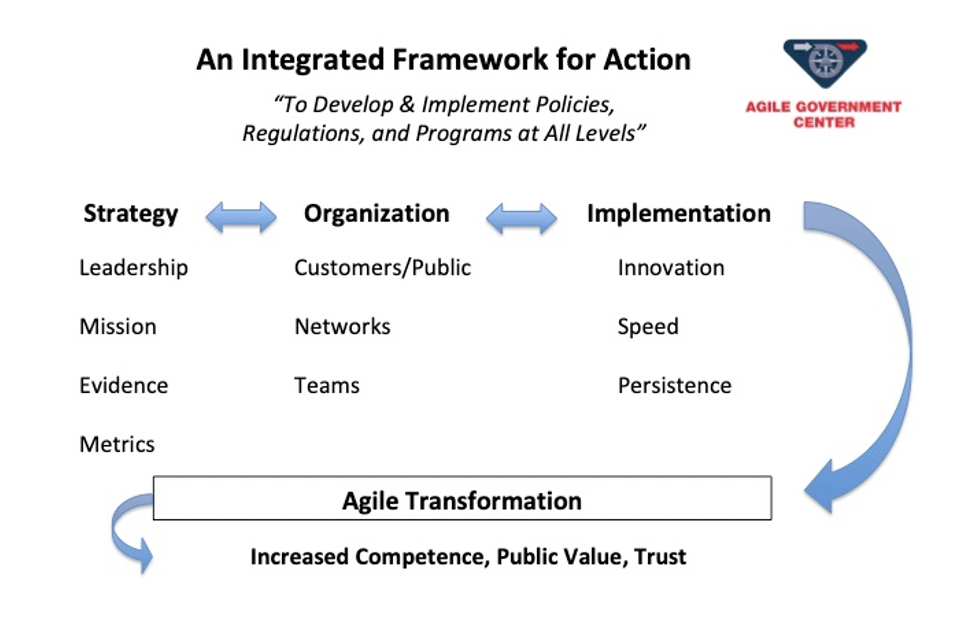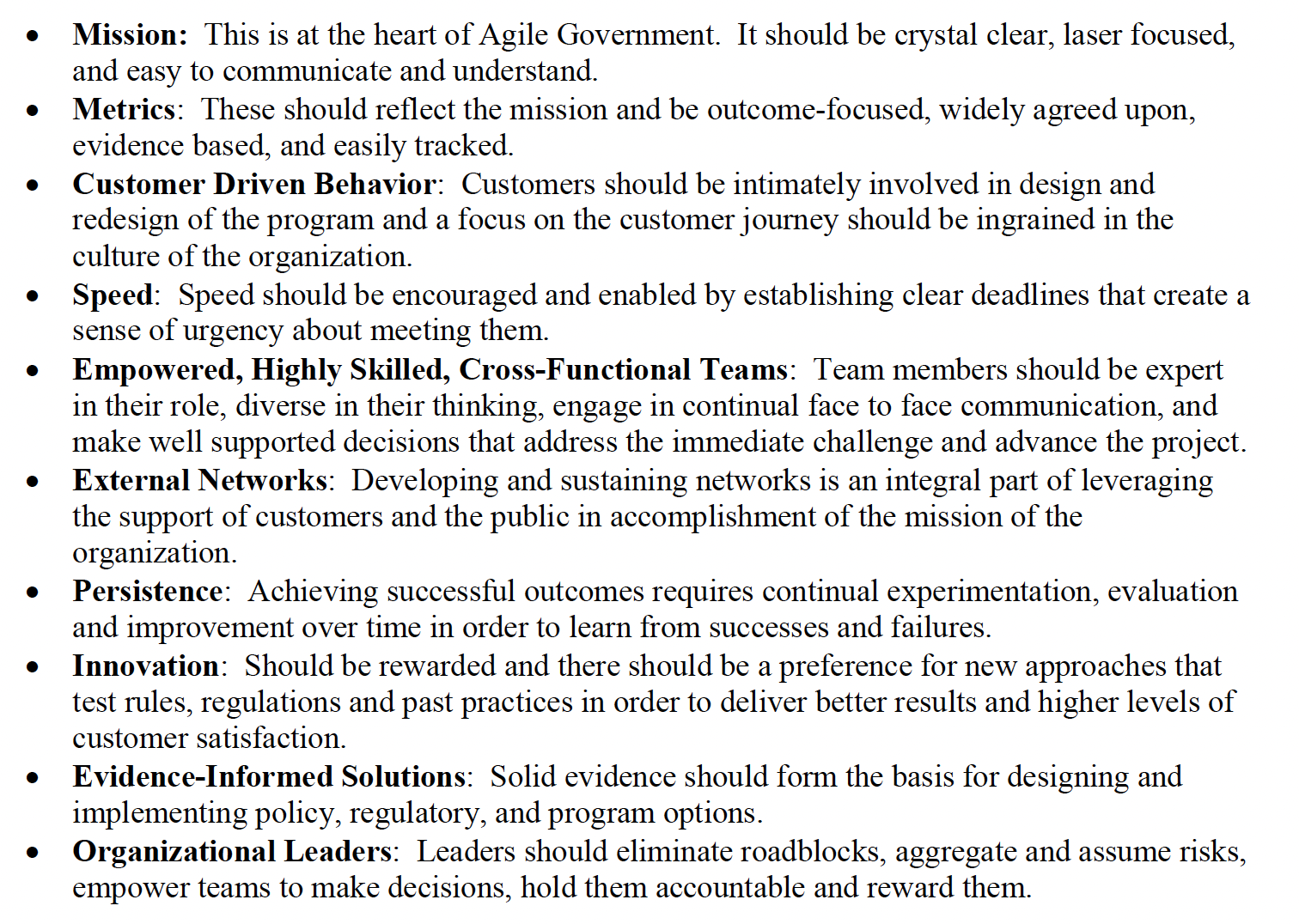This post first appeared on IBM Business of Government. Read the original article.

Center Visiting Fellow Ed DeSeve writes on Principles and Actions for Enhancing Mission Support and Delivery
With the IBM Center for The Business of Government’s next due date for new research report proposals approaching on September 6th, we are publishing additional perspectives on our research topics over the next week in the form of blog posts focused on each topic. The insights in these posts draw from dialogue that helped to frame the research agenda, as well as subsequent content relevant to each research topic area. We hope that these posts provide potential research applicants and authors of upcoming reports with additional context to help frame final proposals and draft reports that follow.
We lead today with the first topic, Driving Agility (authored by Center Visiting Fellow Ed DeSeve). ~
Driving Agility
Principles and Actions for Enhancing Mission Support and Delivery
In his 2016 book, Escaping Jurassic Government, Donald F. Kettl wrote of the “growing gap. . . in what people expect government to do and what government can actually accomplish. . . the conflict of government’s mission increased and the shared commitment to competence has eroded.” He warned that failure to adapt and correct this dichotomy, “could lead American government down the same path that devastated the Jurassic-age dinosaurs.” This is a chilling observation but not one without merit.
How can we improve government’s competence and better address the values of inclusion, integrity and fairness on which trust is based? Research on the use of more agile methods based on “Agile Government Principles” can point to a path forward.
What is Agile?
Agile, actually started at a ski resort in Utah. A group of software engineers, practitioners and programmers met to discuss the need for, “an alternative to documentation driven, heavyweight software development processes.” These processes led to failures to deliver projects on time and frustrations between managers and developers. The participants created the Agile Manifesto, which consists of a set of values and principles that have revolutionized software development and project management.
Author Stephen Denning documents the transformation of the agile approach into an “unstoppable revolution” in the way organizations are managed. He presents “agile” management as: “The new paradigm (that) enables organizations to thrive in a world of rapid and unpredictable change. It enables a team, unit or an entire enterprise to nimbly adapt and upgrade products and services to meet rapidly changing technology and customer needs.”
Can government be agile? Denning has pointed out instances in which the government – the Department of Defense and the Government Accountability Office in particular – have practiced agile behavior. He urges further adoption of agile to improve the public’s satisfaction with government services.
Building on the success of the Agile Manifesto in transforming the way software was developed and projects were managed, and recognizing the benefits that an Agile approach brings, the National Academy of Public Administration created an Agile Government Center (AGC) as a joint venture with the IBM Center for the Business of Government. The purpose of the AGC is presented in Figure 1.
Figure 1: Purpose of Agile Government Center
|
The Agile Government Center will serve as the hub a network that will bring together governments, non-profits, foundations, academic institutions and private sector partners to assist in developing and disseminating agile government principles and case studies of agile policies and programs. This network will be a source of assistance to those who want to adopt and implement agile to provide public goods and services that fully meet customer needs and build public trust. |
In November of 2021, the Agile Government Center released an updated version of the agile government principles illustrated in Figure 2. The principles have been tested in a series of case studies and have been found to be a helpful guide to action. For example, the U.S. Chief Financial Officer’s Council used the principles in creating its “Workforce Modernization Strategy” which will guide the council through 2030.
Figure 2: Agile Principles
The Agile Mindset
Agile government goes beyond software development and project management, to include policy and regulatory development and program implementation. Agile government can be applied at the project, program or whole of government level. In each aspect of government and at all levels, an agile mindset can drive successful implementation of the agile government principles.
An early example of the agile mindset was the response to the Year 2000 computer challenge (Y2K). John Koskinen was chosen by President Bill Clinton to lead a team to address the problem and keep the world running smoothly.
Koskinen was extremely clear about his mission and immediately created a network across the world composed of small teams of experts in each industry. He empowered these teams and their counterparts in the U.S. and other governments to develop solutions to the Y2K problem on an industry-by-industry basis. U.S. teams they reached out to governments around the world to share information.
Koskinen and his small team kept these industry groups working at a rapid pace and helped them innovate solutions. As a result, airplanes did not crash, banks remained open, and hospitals operated normally. Koskinen’s principles of management coincided directly with the Agile government principles. His mindset reflected an outstanding example of agility.
An agile mindset could help managers seeking to confront a crisis or bring about transformation. In today’s world of rapid change, uncertain events, and increasing digitization of information, managers can use Agile Principles as a default mindset to move their organizations forward and better achieve their missions.
Agile Transformation
The concepts espoused by Stanley McChrystal in Team of Teams reflected his own development of an agile mindset. McChrystal’s mission to defeat Al Qaeda needed an approach that mirrored that of the enemy, which reflected a transformation in both strategy and tactics. His entire command had to operate by new rules and procedures. Continual communication with small teams in the field allowed McChrystal and his command to gain a significant advantage against the adversary.
Agile Principles can continue to be refreshed, and research can contribute to such enhancements Studies focus on how to use and disseminate these principles and improve them for new versions. Agile Principles can help an organization to transform, via a “Learning Roadmap” such as that shown in Figure 3. This Roadmap traces the Agile journey from Strategy to Organization to Execution using agile government principles.

Agile and Trust
The Trust research essay presented the OECD Framework that focuses on Competence and Values. Agile Principles are designed to improve Competence and advance Values.
Specifically, an organization can improve competence by clarifying and communicating its Mission, the first task of Leadership. Additional tasks of leadership are setting Metrics, developing and weighing Evidence, and Organizing and Executing a Strategy. The Execution should be done according to an ambitious timing with all appropriate Speed, and must learn from both successes and failure as it Persists despite setbacks. This will require continual Innovation in the approaches to achieving the Mission.
The Values that OECD discusses for improving trust in government: Integrity, Openness and Fairness- will guide the Organization of the work by assuring that the voices of Customers are included in the work of the Teams.
In fact, inclusion of Customers and their satisfaction is essential to the agile mindset. In government, the word “customer” has a broader meaning than in the world of commerce, with three roles:
- As Recipients of Direct Services – Services such as Social Security, trash collection, and the postal service, that individuals use every day.
- As Beneficiaries – Individuals receive benefits indirectly, such as public safety, clean air, good roads, clean safe water, and public health.In this case, the benefit is clear and measurable but not directly provided to a single individual.
- As Participants – The role of the public here includes voting, participating in protests, serving on oversight boards, commenting on regulations and policies and other areas that reflect the full exercise of Constitutional and legal rights.
Research can frame how all three roles should be recognized in order to increase the trust that the public has in government.
Finally, integrity can be improved by using third party networks to oversee waste, fraud, and abuse. Currently, the Pandemic Response Accountability Committee has created an Agile Products Tool Kit to help oversee the more than five trillion dollars that the network of Inspectors General and others are overseeing. This tool kit provides rapid useful information to improve the Integrity of various legislative initiatives for which they are responsible.
Conclusion
Research on agility in government can help government officials seek to deliver better programs, policies and regulations at all levels. Agile government is designed to create a new mindset to replace the default mindset of bureaucracy that constituted “Jurassic Government”. The rapid pace of changes in society, particularly those involving technology, require a new form of management that can delivery mission results reliably, responsively, and with integrity, fairness and openness.

